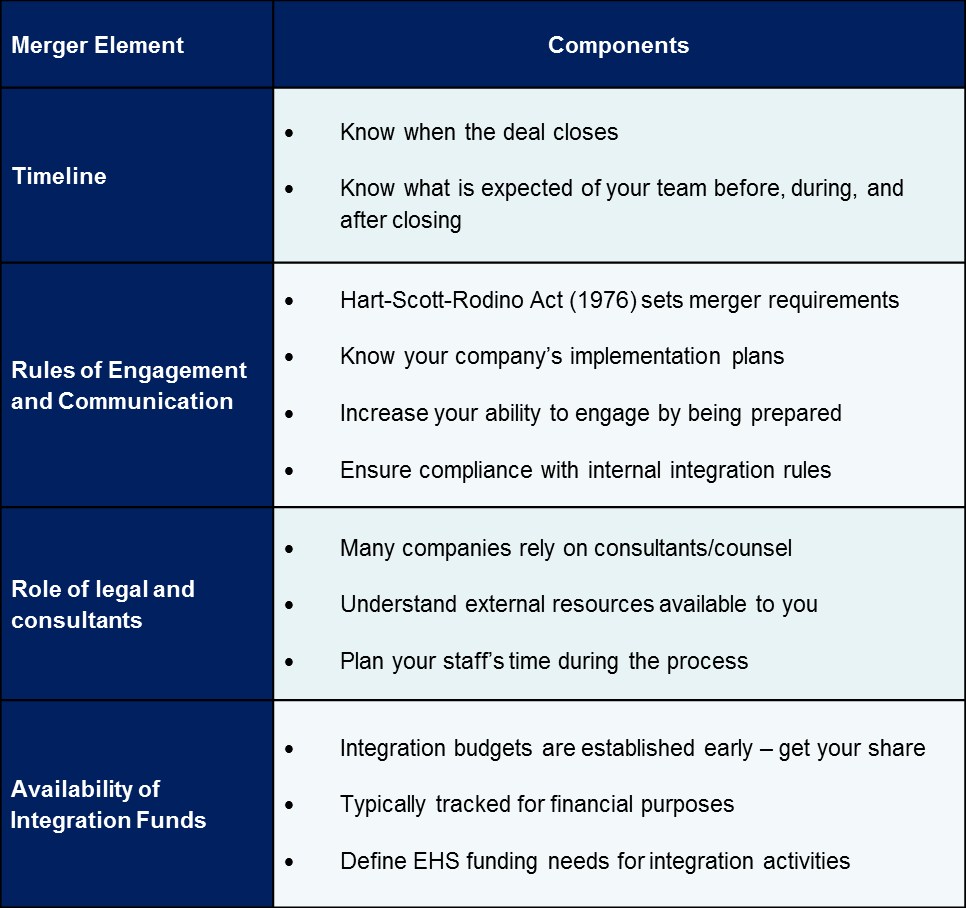EHS Leadership: I’m being acquired…now what?
Oct 27th, 2015 | By John D'Agostino / Donna Wiley | Category: Featured Articles
Contemporary businesses regularly use mergers and acquisitions (M&A) to the extent that, at any given point, many large companies are simultaneously integrating and divesting a portion of their portfolio. While the acquiring company often drives environmental, health, and safety (EHS) integration, EHS leaders for the company being acquired are frequently presented with an opportunity to add value and help facilitate the process. Since EHS is just one of many functions being merged/integrated into the new company, you will be competing with Human Resources, Legal, Finance, Sales, Information Technology, Supply Chain, etc. for time, attention, and resources, but there are specific strategies that can prepare you and your team for integration into a new company’s structure and processes. It demands confidence to navigate rapidly changing circumstances, and the most successful EHS leaders at companies being acquired actively prepare for post-merger integration (PMI). Those who follow well-thought-out strategies for their areas of responsibility will drive teams and organizations to experience a smoother and more efficient integration experience over the long term.
What Can You Do?
Embrace change. Your company decided that a merger makes business sense. While not your decision, embark upon this period of change in a proactive, forward-looking manner. Start with your staff; talk to them. Every person likely has similar questions, and understanding your staff’s concerns will allow you to raise their issues to the right people at the appropriate time.
Understand Integration Mechanics. Merging two companies requires logistical and cultural change. Smart EHS leaders will first understand the logistics of how the merger will unfold. At a minimum, you should understand the elements in Table 1.
Table 1: Post-merger Integration Mechanics

Prepare for the change. If integration information is not provided, get your house in order anyway. Simple things make the difference: know the status of your facility permits to streamline the transfer process, summarize legacy contamination liabilities, outline team/divisional/functional structures, and understand your cultures’ strengths and weaknesses. Financial data such as past and current spending, operating budget needs, and capital investment, should all be included in your evaluation.
What Shouldn’t You Do?
Bury your head. Pay attention to changing corporate dynamics. Attitude and a willingness to lead are recognized and rewarded with opportunities for career advancement. Your group will be analyzed and compared; know your team’s strengths and weakness and be honest about them.
Lose momentum. Continue to do your day job and add in your integration tasks. Not meeting your annual goals at any point in the year is unadvisable. It will pay off in the long run if you keep an even keel now. Integration plans are prepared at a fairly high level, but they are not set in stone and do change with time. It’s just your new reality.
Bemoan change. Do not be, or be seen as, an obstacle. Rather, strive to be a positive influence. Supportive team players, who continually look for opportunities to improve integration efficiency and effectiveness, will be noticed and rise to the top. Always seek opportunities to add value to the integration process.
Conclusions
Being acquired can be inspiring; specifically because as things are changing you are presented with an opportunity to add value. Embrace it like your job depends upon it — because it does. EHS leaders at acquired companies often mistakenly believe that they are at a disadvantage initially, but a corporate takeover doesn’t mean that your career has come to an end. Having a plan that is appropriate for you, your team, and your culture is important. Following a few simple principles can enhance your success:
- Embrace the change and enhance the chances of success for you and your team
- Understand merger integration mechanics and what is expected of you and your team
- Prepare for the integration and demonstrate value by “having your house in order”
- Keep your eyes open, understand your culture, and message it properly
- Do your day job enthusiastically and add your integration responsibilities — this is not optional
About the Authors
John D’Agostino is a sustainability consultant and senior partner at Environmental Resources Management (ERM), where he serves as the Managing Director for North American Practice Areas. He has more than 20 years of international experience in client development, operational management, and people leadership. His primary focus areas include management consulting, transaction services, contaminated site management, regulatory negotiation, large-scale construction oversight, and evaluating environmental liabilities and reserves.
Donna Wiley is a business development and client relationship executive at ERM. She has more than 20 years of experience assisting industrial, commercial, and service sector clients in the evaluation, pursuit, implementation, and management of new processes and technology to meet strategic business objectives.
Other Post-merger Integration Articles in the EHS Journal
- After the Deluge: Designing EHS Organizations for Post-Merger Companies by Scott Nadler and Michael Bittner
- Mergers, Acquisitions, and EHS by Michael Bittner
- EHS Post-merger Integration for Spin-offs by Michael Bittner and Walt Shill
- Post-merger Integration Challenges in the Agrichem Sector by Michael Bittner, Kristine MacPhee, and Ashley Armstrong
Photograph: Modern Rhombus Façade Texture by Michael and Christa Richert.
Return to the EHS Journal Home Page


[…] EHS Leadership: I’m being acquired…now what? by John D’Agostino and Donna Wiley […]
[…] EHS Leadership: I’m being acquired…now what? by John D’Agostino and Donna Wiley […]
[…] EHS Leadership: I’m being acquired…now what? by John D’Agostino and Donna Wiley […]
[…] EHS Leadership: I’m being acquired…now what? by John D’Agostino and Donna Wiley […]